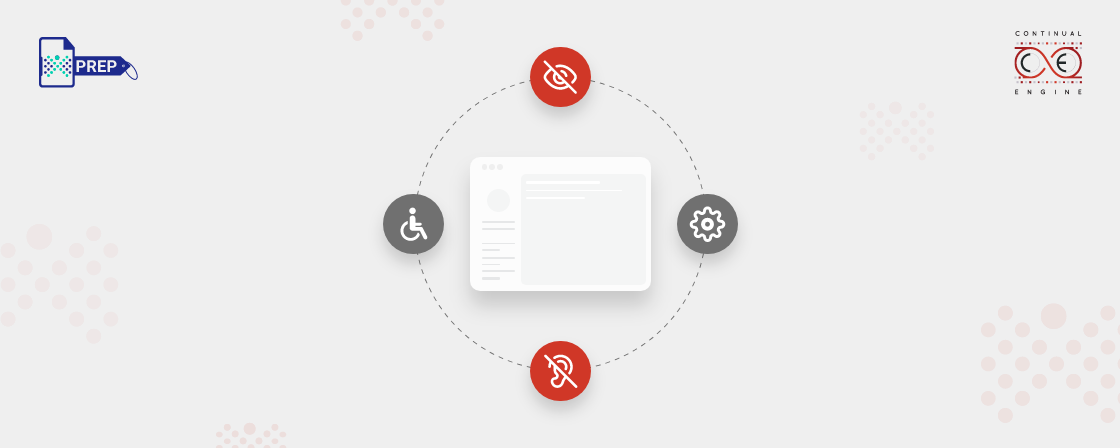Key Takeaways
- Accessibility testing ensures people with disabilities have access to software, websites and other digital content.
- Testing accessibility can be done manually, automated, or hybrid form.
- Automation is the ideal choice. It is less time consuming, cost-efficient, and ensures compliance.
- There are different ways of testing accessibility depending on the disability, such as vision, hearing, mobility, and cognition.
What and why: Accessibility testing
Accessibility Testing is software testing that ensures websites and applications can be used by as many people as possible, including those with disabilities such as vision impairment, hearing disabilities, physical and cognitive conditions, and other disadvantaged groups.
Why is Accessibility testing a necessity?
The primary purpose of accessibility testing is to ensure people with disabilities can enjoy access to software, websites, and assistive technology.
It is also the law. Accessibility testing intends to understand if digital content meets the needs of people with disabilities through established accessibility standards:
- Web Content Accessibility Guidelines (WCAG) to increase a website’s user-friendliness.
- Section 504 & Section 508 of the Rehabilitation Act for equal access to opportunities, services, and technology.
- The Americans with Disabilities Act (ADA) strongly prohibits discrimination.
Failure to do so could result in hefty fines and expensive lawsuits.
How is Accessibility testing done?
Testing accessibility is done manually, can be automated, or a hybrid of both. These general testing approaches are primarily used
- Automatic testing – The most common and cheapest approach is generally performed with a spider that gathers pages, and the resulting discovered pages are diagnosed.
- Quick test – Using automatic testing as the base, this approach tests against a limited set of manual tests. It provides a good hybrid of coverage for critical accessibility issues.
- AT testing – This approach focuses on testing in one or a few assistive technologies. It determines if the system works with specific technology. Still, it limits results to particular assistive technologies and disability types.
- Audit – A formal audit is costly and time-consuming. It includes testing for all the normative issues and functional validation in assistive technologies.
Read more about Automated vs Manual Accessibility Testing
There are also different ways of testing accessibility depending on the disability:
- Mobility - People with motor disabilities generally cannot use the keyboard or mouse alone. Here, testing access tools such as a special keyboard ensure easy typing and usability if all mouse operations can be functional.
- Cognition - Users with cognitive disabilities may have poor memory and learning difficulties. Testing ensures that websites have simple navigation with accurately labeled forms, buttons, and other elements, which makes it easy for the user to understand and operate.
- Hearing - Sensory disabilities like deafness can make understanding audio and video content challenging. Alternative text and closed captioning that convert spoken words to text can be used in testing accessibility for a deaf person.
- Vision - Vision disabilities range from complete blindness and poor vision abilities to color blindness. Testing strategies can include using access tools like screen reader software and screen magnification software for its users.
Automate Everything
The optimum accessibility testing solution is entirely automated. Automated accessibility testing evaluates your documents, web pages, or multiple websites simultaneously for accessibility issues. Not only is it time and cost-efficient, but it is also essential to ensure compliance with accessibility standards and avoid penalties.
It may be impossible to test everything automatically. Still, automation is the ideal choice. Here’s why:
- The expense of accessibility testing is mainly driven by the accessibility standards that must be checked manually. Cutting those expenses while maintaining the scope of testing can be beneficial.
- Many tests fall under "Guided Automatic" tests – the direct test must be performed manually. Proper use of these tests could lower the manual tests needed.
- Once a manual test is performed, the result can be stored. This would allow the results of previously completed tests to be automatically applied to similar situations.
- Many manual tests seem complex but are simple once the issue is identified. The use of InFocus Toolbar preview modes makes it possible to quickly and easily detect complications.
Sample Test Cases Accessibility Testing
You can follow WCAG compliance standards by using this summarized checklist of what accessibility testing consists of regarding textual content, design, development of the website, and access tools:
- Are the labels correctly written and placed in the application?
- Are the audio and video content audible and visible for disabled people?
- Is the color contrast ratio maintained and viewable?
- Do the control actions for video content work well?
- Are keyboard shortcut keys provided for all mouse operations, windows, and menus?
- Do the ordered tabs make navigation easy?
- Is the heading unique and conveys the meaning & structure?
- Is the link text written with a content description?
- Are meaningful multimedia captions provided?
- Are the instructions provided straightforward, easy to understand and operate the application using the documentation?
- Does the application support all operating systems?
- Is the response time of each screen or page clearly mentioned so that users know how long to wait?
- Are the images used appropriately to be easily understood by the users?
- Does the application have audio alerts?
- Is a user able to adjust audio & video controls?
- Can the user adjust or disable moving displays?
- Is training provided for users with disabilities to familiarize them with the software?
Conclusion
Accessibility testing aims to assess if your digital tools are easy-to-navigate, is accessible, and is easy to understand. While it benefits everyone, it is especially helpful to people with disabilities. That is why using it in your testing access strategies is important, not as a consideration- it should be a priority.
